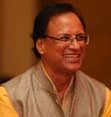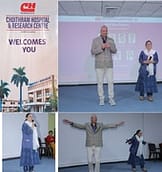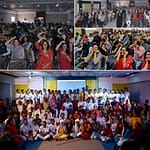☆ Laughter Therapy for cancer patients: A Journey of Healing and Joy ☆ Mr. Jagat Singh Bisht ☆
1st February 2025 was a day of deep fulfilment and profound connection. My wife, Radhika Bisht, and I, Jagat Singh Bisht, both Laughter Yoga Master Trainers, had the privilege of conducting a Laughter Therapy session for cancer patients at the renowned Choithram Hospital & Research Centre auditorium in Indore, Madhya Pradesh, India.
The room was filled with patients and survivors, accompanied by their caregivers, all seeking solace and hope. They looked to their doctors, nutritionists, physiotherapists, and nursing staff for guidance and strength. Yet, behind their silent expectations, we could sense the weight of their struggles.
At the outset, setting the tone for the session was a challenge. The room bore a sombre atmosphere, heavy with uncertainty. However, we knew that where words might falter, laughter could heal.
We introduced them to laughter therapy, explaining its incredible health benefits, particularly for cancer patients. To inspire hope, we shared stories of resilience—Norman Cousins’ revolutionary insights in Anatomy of an Illness, Patch Adams’ Clown Therapy, and Otto Warburg’s groundbreaking research on oxygen supply to human cells. We recounted the remarkable journey of Desmond Nicholas from Melbourne, who battled colon cancer relapse with laughter therapy, having met Dr Madan Kataria, the founder of Laughter Yoga, in Bengaluru and us in Indore in 2011.
What began with hesitation soon transformed into enthusiasm as we guided them through the structured steps of Laughter Yoga—clapping and chanting, deep breathing, childlike playfulness, and laughter exercises. With every passing moment, their smiles grew wider, their laughter more uninhibited.
The response was overwhelming. Witnessing their spirit rise, we immersed them in a wide range of laughter exercises: Greeting Laughter, Milkshake Laughter, Mobile Laughter, Lion Laughter, Bird Laughter, Calcutta Laughter, Age Laughter, Laughter Point, Hearty Laughter, Tak Jhoom Laughter, Argument Laughter, Time to Laugh, Laughter Cream, Silent Laughter, and Gradient Laughter. As laughter filled the hall, so did a palpable sense of release—of burdens momentarily set aside, of suffering lightened by shared joy.
Towards the end, we led them into a soothing laughter meditation and deep humming, culminating in the closing ritual—our laughter yoga prayer for health, happiness, and world peace, extending to all corners of the world.
The energy was contagious. Even those outside the immediate session—the photographers, reporters, volunteers, and technical staff—found themselves drawn in, unable to resist the infectious joy of the moment.
The ultimate litmus test of the session came not just in the laughter but in the standing ovation that followed. Tears welled up in the eyes of many as they expressed their gratitude, their hearts lighter than before. We were overwhelmed by the depth of their response.
A meaningful life is a life of service. When we give beyond ourselves, we create something deeply purposeful. This session reaffirmed that happiness multiplies when shared, and healing becomes possible when approached with love and kindness.
This was our first complete session after the disruptions of Covid-19, conducted at the invitation of Dr Suruchi Singh, Radiation Oncologist, and Dr Rajesh Patidar and Dr Vikas Asati, Doctors of Medicine in Oncology. The session was deeply appreciated by Dr Sunil Chandiwal, Director, and Sumit Nandedkar, CEO, who recognised the significance of laughter in holistic healing.
Anil Kumar Lakhwani, Deputy Director of Health Services, and Mukesh Sharma, Public Relations Officer, pledged to begin their days with at least a couple of laughter exercises—a testament to the impact of the session.
The hall was packed with cancer patients, survivors, caregivers, doctors, physiotherapists, dieticians, nursing staff, and medical students, all united in this joyful experience. We are immensely grateful to the Oncology Department of Choithram Hospital & Research Centre for this invitation. The memory of this day will remain etched in our hearts for a long time.
Giving our best, witnessing the gratitude in their eyes, and feeling the profound fulfilment of service—this is why we do what we do.
As we approach World Cancer Day on 4th February 2025, may we all be reminded that laughter is not just an expression of joy, but a powerful medicine for the soul.
🌹🌸💐🙏😄 🤣
© Jagat Singh Bisht
(Master Teacher: Happiness & Well-Being, Laughter Yoga Master Trainer, Author, Blogger, Educator, and Speaker.)
Founder: LifeSkills
A Pathway to Authentic Happiness, Well-Being & A Fulfilling Life! We teach skills to lead a healthy, happy and meaningful life.
The Science of Happiness (Positive Psychology), Meditation, Yoga, Spirituality and Laughter Yoga. We conduct talks, seminars, workshops, retreats and training.
≈ Editor – Shri Hemant Bawankar/Editor (English) – Captain Pravin Raghuvanshi, NM ≈



















